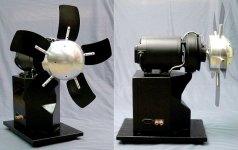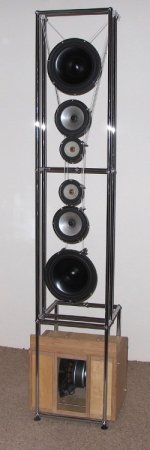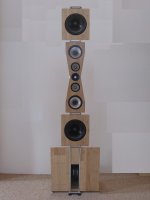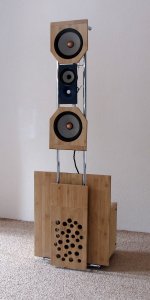Not exactly. I was thinking of doing it without gearing. So the available torque directly twists the fin. Even the bearing for the central axle would ideally be magnetic to avoid frictional glitches when changing direction. Maybe that could also be avoided with a kind-of spider with rotational freedom. It's all open.
Maybe I'm off the mark here, because it seems like the torque would have to be a lot higher than for a typical woofer. But this should be a good thing. Multiply the surface area by 10x, and estimate the swept volume, and adjust the motor size to suit. A cone shape with a compound curve is a much stronger shape than a flat wing, but maybe it doesn't need to be flat? Some kind of sandwich with a light-weight foam between some strong fibres?
Maybe I'm off the mark here, because it seems like the torque would have to be a lot higher than for a typical woofer. But this should be a good thing. Multiply the surface area by 10x, and estimate the swept volume, and adjust the motor size to suit. A cone shape with a compound curve is a much stronger shape than a flat wing, but maybe it doesn't need to be flat? Some kind of sandwich with a light-weight foam between some strong fibres?
Last edited:
The Eminent Technology TRW-17 is in the market since long ago. Not sure if this is exactly what you propose. I do not remember now but I think the blades not only rotare they change angle too.Not exactly. I was thinking of doing it without gearing. So the available torque directly twists the fin. Even the bearing for the central axle would ideally be magnetic to avoid frictional glitches when changing direction. Maybe that could also be avoided with a kind-of spider with rotational freedom. It's all open.
Maybe I'm off the mark here, because it seems like the torque would have to be a lot higher than for a typical woofer. But this should be a good thing. Multiply the surface area by 10x, and estimate the swept volume, and adjust the motor size to suit. A cone shape with a compound curve is a much stronger shape than a flat wing, but maybe it doesn't need to be flat? Some kind of sandwich with a light-weight foam between some strong fibres?
Attachments
The rotating fan picture reminds me of a "helicopter" technique I'd heard of. Apparently, if coupled with room-sized enclosures / infinite baffles, it was capable of ridiculously powerful 1Hz - 40Hz bass. But what I had in mind was more like a fin flapping on a stationary hinge, like an aileron fin.
If the displacement is too big, I think overcoming wind noise at the 'dipole' edge could be a factor.
~~~
Another, more conventional route without re-inventing the wheel ( / motor) so much, could be to retrofit a woofer. E.g.: taking the magnet and voice coil from a conventional woofer and replacing everything else with something like a BIG styrofoam + fibre sandwich dish. It would be a bit like an actuator, except that the magnet scaffolding would be extended all the way out to the edge of the sandwich.
If the displacement is too big, I think overcoming wind noise at the 'dipole' edge could be a factor.
~~~
Another, more conventional route without re-inventing the wheel ( / motor) so much, could be to retrofit a woofer. E.g.: taking the magnet and voice coil from a conventional woofer and replacing everything else with something like a BIG styrofoam + fibre sandwich dish. It would be a bit like an actuator, except that the magnet scaffolding would be extended all the way out to the edge of the sandwich.
Yes Vic has tried loads of drivers etc, but the one thing that he has remained extremely happy with throughout is the 18” woofers in clamshell arrangement. I know someone who has heard that system and he said it is the best bass he has ever heard, FWIW.Based on the sheer number of systems shown, this person seems to make a new speaker every couple of weeks. Lots of enthusiasm. Many of his designs include some serious flaws. You can tell just by looking at them, what drivers are used, how large the drivers are, etc. You can't escape physics.
Also, very very light on measurements (essentially none) and I did not see much details in terms of crossover design, etc. Anyone can slap together some drivers in whatever configuration and use some DSP to "make it work" by using their ear (the worst way to design any type of loudspeaker except a simple fullranger). It's a recipe for what you see here, never satisfied and continually trying something new.
Although a couple of the systems with nude drivers on a "stick" above a compound dipole woofer setup have some merit I see little mention of how the crossovers were designed and implemented. Oh, I see now, this quote kind of sums it up:
Guy seemingly has no clue how to do anything properly. It's just random stuff that he tries based on whatever...
This should serve more as an example of how NOT to design and build speakers!
It might look indeed beautiful /tech-neardy with the decent charm of a naked bike or a steampunk object. Optically speakin, also I like it. But sorry. I am rather the FFF guy - form follows function. From the acoustic point of view, such a configuration (partially) cancels the 2nd harmonic distortion. However, this goal can be better attained from an acoustically/technically/economically point of view. Late Siegfried Linkwitz showed how, such as e.g. in the LS LX521. Therefore in my oppinion, such a clamshell config is (nearly nothing but) a 50% waste of ressources. But never mind. If it looks good .... The show must go on, they say ... Really? Remerber also late Marcel Dassault: "Un bel avion est un avion qui vole bien". So sorry, clamshell design. Ce n'est pas vraiement beau.... 18” woofers in clamshell arrangement ...
Wow !!!I know someone who has heard that system and he said it is the best bass he has ever heard.
Last edited:
I don’t think anyone would argue that it is the most efficient way of using 2 woofers. There are other factors to consider though:
1. If you are limited for space then it’s a way of increasing your effective output / decreasing excursion per driver without taking up much more width or height.
2. There may well be a reduction in distortion as a result of the drivers being suspended and not fixed to a baffle.
Everything is a compromise in this hobby; you pick the ones that you think will work best for you.
1. If you are limited for space then it’s a way of increasing your effective output / decreasing excursion per driver without taking up much more width or height.
2. There may well be a reduction in distortion as a result of the drivers being suspended and not fixed to a baffle.
Everything is a compromise in this hobby; you pick the ones that you think will work best for you.
Cool 🤩I managed no more than 105 dB @ 20 Hz with less than 10% THD on my giant H-baffle towers, that had sixteen 21" woofers.... so ... unless you are willing to go completely mad, just forget it.
No. It's not the way this works in OB. You may roam around at linkwitzlab.com for an extended understanding.1. ... a way of increasing your effective output / decreasing excursion per driver ...
To be fair in your favor: Hummm ... maybe, if you mean these (non-harmonic) distortions due to erratic baffle modes if the baffle is ill-conceived and prone to heavy resonances. You will stimulate them less if you hang yor driver into or onto a baffle instead of fixing them to it. But even then, take care: The baffle will show less total mass also. Less by the driver's mass. And surprisingly enough you will completely avoid these distortion products if there is no baffle at all.2. There may well be a reduction in distortion as a result of the drivers being suspended and not fixed to a baffle.
As for the robust principle of reducing 2nd harmonics in bass reproduction I was referring to, this principle has nothing to do with suspending or fixing a driver to a baffel or into nothing. It's the cancelling mechanism that the drivers dynamic nonlinearities are partially cancelled if they work in antiphase mode.
Last edited by a moderator:
It might look indeed beautiful /tech-neardy with the decent charm of a naked bike or a steampunk object. Optically speakin, also I like it. But sorry. I am rather the FFF guy - form follows function. From the acoustic point of view, such a configuration (partially) cancels the 2nd harmonic distortion. However, this goal can be better attained from an acoustically/technically/economically point of view. Late Siegfried Linkwitz showed how, such as e.g. in the LS LX521. Therefore in my oppinion, such a clamshell config is (nearly nothing but) a 50% waste of ressources. But never mind. If it looks good .... The show must go on, they say ... Really? Remerber also late Marcel Dassault: "Un bel avion est un avion qui vole bien". So sorry, clamshell design. Ce n'est pas vraiement beau.
Since you aware of SL's analysis, yes it's a compound dipole. As long as you leave at LEAST a few inches in between the two drivers the resulting output is essentially the sum of two dipoles and you get some 2nd order harmonic reduction. So it is not really that bad overall. SL decided to use an M-frame in teh LX521, and that has its own issues.
This is a really interesting aspect.As long as you leave at LEAST a few inches in between the two drivers the resulting output is essentially the sum of two dipoles and you get some 2nd order harmonic reduction.
I guess it will be a continuum between the two benefits you mention.
- Stuck together, at a distance d/lambda=0, you will get SD=1 and HD2_cancel=Max. So you cannibalize one SD for HD2 cancellation.
- Steadily increasing d, you will get 1 < SD < 2, and less HD2_cancel. And you will get comb filtering due to phase delays between the two drivers.
Now let's talk about your certainly true, but a bit vague "... at LEAST a few inches ..." statement. In terms of this incriminated 18-inch-clam, d seems to be about some 3 ... 4 (max) inches. Talking of bass, take f=100Hz, and then d=4 Inches corresponds to lambda=0.03. Do you really think that "few inches" == 4 inches == lambda=0.03 make a significant difference to a "closed" clam at d=0 ? I don't. What happens when d reaches lambda=0.1? Or 0.2? And above this, probably better forget it, you will begin to struggle into comb filtering artefacts due to phase shifts.
This is why I am asking for illustrative graphs.
Ceterum censeo OB clamshell esse delendam ...
Last edited:
OK, OK, I did not pull this info out of thin air... I made measurements in late 2021 of two 12" drivers at various separations to investigate just this situation. See this post and attached measurements:
https://www.diyaudio.com/community/...eless-full-range-speakers.374043/post-6729463
Also there are many posts and measurements by others scattered through that thread.
In my own measurements I found that very small separations of about 1" to 2" resulted in an SPL level that was about 3dB less than when the two drivers were separated by about 6" or more. The drivers were arranged face to face, so I am referring to the separation of the two mounting flanges. As you increase separation nulls appear in the response at increasingly lower frequency but the low frequency SPL is not changing. This tells me that you should use some minimum separation and that seemed to be about 4" to 6" in my case.
https://www.diyaudio.com/community/...eless-full-range-speakers.374043/post-6729463
Also there are many posts and measurements by others scattered through that thread.
In my own measurements I found that very small separations of about 1" to 2" resulted in an SPL level that was about 3dB less than when the two drivers were separated by about 6" or more. The drivers were arranged face to face, so I am referring to the separation of the two mounting flanges. As you increase separation nulls appear in the response at increasingly lower frequency but the low frequency SPL is not changing. This tells me that you should use some minimum separation and that seemed to be about 4" to 6" in my case.
IMO...
Speakers are mostly `drivers in boxes' that are attempts to `manage' resonances etc. Another extreme is the infinite baffle which seeks to avoid dealing with the rear wave completely. When using an open baffle you are still managing the rear wave, but what is an H baffle except a very short pipe?
What kind of dynamic response do you want at say 20Hz?
Seems like it gets kinda tricky to get better than around 50ms.
However, I'm also pretty certain you haven't tried it.😉
But seriously aside from film effects, what are people listening to at these frequencies?
Speakers are mostly `drivers in boxes' that are attempts to `manage' resonances etc. Another extreme is the infinite baffle which seeks to avoid dealing with the rear wave completely. When using an open baffle you are still managing the rear wave, but what is an H baffle except a very short pipe?
What kind of dynamic response do you want at say 20Hz?
Seems like it gets kinda tricky to get better than around 50ms.
However, I'm also pretty certain you haven't tried it.😉
But seriously aside from film effects, what are people listening to at these frequencies?
A typical boxed speaker should have WAY more energy storage issues than an OB unless the OB uses a huge baffle and there are panel resonance issues. I get around that by using practically zero baffle!I'm pretty certain I would find such a speaker unlistenable due to the huge energy storage blurring the dynamic response...
Edit: Oh wait, I think you were referring to "El Pipe-O"!
Thank you for the link. This thread completely passed me by, because I was busy with Quad63's by then. I like your approach of this kind of empiric research! It's the best way to amuse yourself by learning a lot about speakers system behavior, curiously elaborating into a new field of knowledge! Cudos !!!I made measurements in late 2021 of two 12" drivers at various separations to investigate just this situation. See this post and attached measurements
In terms of your no-baffle or nearly-no-baffle approach, for me I came to the conclusion that the no-baffle approach has more drawbacks than a minimum-baffle approach, speaking so for the mid to the higher frequency registers. And while you keep your baffle minimum (e.g. + 5mm from the outer driver's rim), you don't waste too much in terms of horizontal constant directivity. Vertical CD instead is always a mess, even resorting to Horbach-Keele designs. And I have the impression that a slim baffle with a continous shape will give a smoother frequency response because of more or less evenly distributed baffle artefacts along the wave propagation in the frontal plane. This much for the off-topic section of my post, but I would like to know about your experiences in terms of this mid-high range topic anyway. Naked vs. Slim.
Naked vs. slim instead in terms of bass seems a no-brainer to me. Learning by iterating, I was very, very annoyed to realize how physically big a bass solution must get to produce "deep" bass even at a moderately decent SPL level. Im a tech enthousiast, but I do not want to live inside of, or surrounded by a speaker system, anyhow. And I understand with the appropriate condolescence that you reverted to CB for the lowest octaves, giving up all the beauty and promises a minimum-compromise OB bass solution could seduce with. As for me, I resigned completely and not only gave up the idea to reproduce deep bass with an OB, but also gave up to produce deep bass even in a standard setup altogether. Speakers must not dominate by theirs presence. This is my credo.
Making another allusion to Siegfried Linkwitz then, borrowing from his "watson" approach: https://www.linkwitzlab.com/Watson/watson.htm.
Why would you produce deep bass out from the location of the standard 60° stereo setup drivers, only to earn a mess of echoes and standing waves from your room? It's a paradox: You have two bass-capable, monster speakers to throw low frequency signals into a closed surrounding, a sound energy which you then deliberately try to tame in order that it should best be absorbed before messing everything up acoustically. Instead, all that matters would simply be the direct signal from membrane (speaker) to membrane (tympanon). So why not radically change the physical approach: You are an audiophile listener, allright? So you will anyway sit at the sweetspot for best results. And then, you also might produce your bass a bit more next to your ears. At lower level. And at lower room artefacts. Basically, something like Siegfried Linkwitz experimented with along with a pair of auxiliary watson speakers next to his listening spot. So take this approach of SL's. All you have to do is to modify it a bit and place some left and right woofers instead, there. Instead of a fullrange watson speaker. And you have to delay theirs feeding signal by DSP such as the soundwave arrival time from these LF auxiliar drivers match with the regular stereo OB speakers placed away on the standard 60° setup. And you have to match their SPL output to the arriving direct sound from the regular stereo OB speakers. Thus, you might limit the main OB speakers to say 150Hz, and the rest will then gently be handled by the nearby CB (or even considerably downsized bass OB, why not, they don't need to produce this high SPL any longer ...) bass helpers nearby you. Resorting to DSP, you also could implement these auxiliary bass units as fillers, leaving the "natural" low frequency shape of the regular stereo OB as is. Altogether at much lower bass SP level, and such sparing the whole room from be filled by unwanted and potential messy sound energy. But take care not to place these auxiliary bass complementers in a way that you get direct reflections from the propagated direct sound coming from the regular stereo OB's. And this way, your ...
BIG BASS will need neither an amazing array, nor a big baffle, nor a curious clam.
Disclaimer: I did not try this at home ...
Addendum: Three desperate (in terms of bass) iterations of mine with steadily growing OBbass
Attachments
Last edited:
Thanks for the extended comments @Daihedz. It is easy to get a bit lower than 150Hz IMO. I have found that a baffle of 20x20 inches is large enough for bass response down to below 100Hz. I choose low distortion drivers, and my cutoff point is currently around 70Hz, so that is about one octave lower that what you suggested. This allows the dipole to be a 3-way, 3-driver design that has plenty of SPL output and sounds good even way off axis.
I use two subwoofer columns placed on the front wall, each consisting of four 12" drivers in individual 1.5cuft cabinets. They are only making the lowest notes. I will be replacing these this summer with a 12ft^3 box located just behind my listening chair and containing two 21" B&C woofers. These will have much less distortion than the cheap 12" subs I am using now. Nearfield bass can be very good and I am really looking forward to firing up that system in a months from now.
I use two subwoofer columns placed on the front wall, each consisting of four 12" drivers in individual 1.5cuft cabinets. They are only making the lowest notes. I will be replacing these this summer with a 12ft^3 box located just behind my listening chair and containing two 21" B&C woofers. These will have much less distortion than the cheap 12" subs I am using now. Nearfield bass can be very good and I am really looking forward to firing up that system in a months from now.
- Home
- Loudspeakers
- Multi-Way
- Open baffle (deep) bass reproduction?





